

Tales of Graces f Remastered was provided by Bandai Namco for review. Thank you!
I love JRPGs. When I think about my favorite types of games, JRPGs always rise to the top of the list. I love the epic scale of what's at stake, the intriguing crafted worlds, the exciting combat, the semi-deep progression systems, and the stories they tell. It blends to create an incredible experience that I can't stop playing. However, I will never forget the game that got me into JRPGs in the first place: Tales of Symphonia. I was mesmerized by the scale of the game and blown away by the fact that it needed two GameCube discs to play, and it sucked me in almost immediately.
Since then, the Tales series has been one of my favorite JRPGs. There are a lot of amazing entries in this genre that excel in many areas, but the Tales series has always stood out because of how they tell their stories, how combat works, and, most importantly, how they handle their characters. Tales of Graces f Remastered is the next release for this series, and even though it was originally released over 15 years ago, it still enticed me and holds up today as a go-to JRPG to experience.
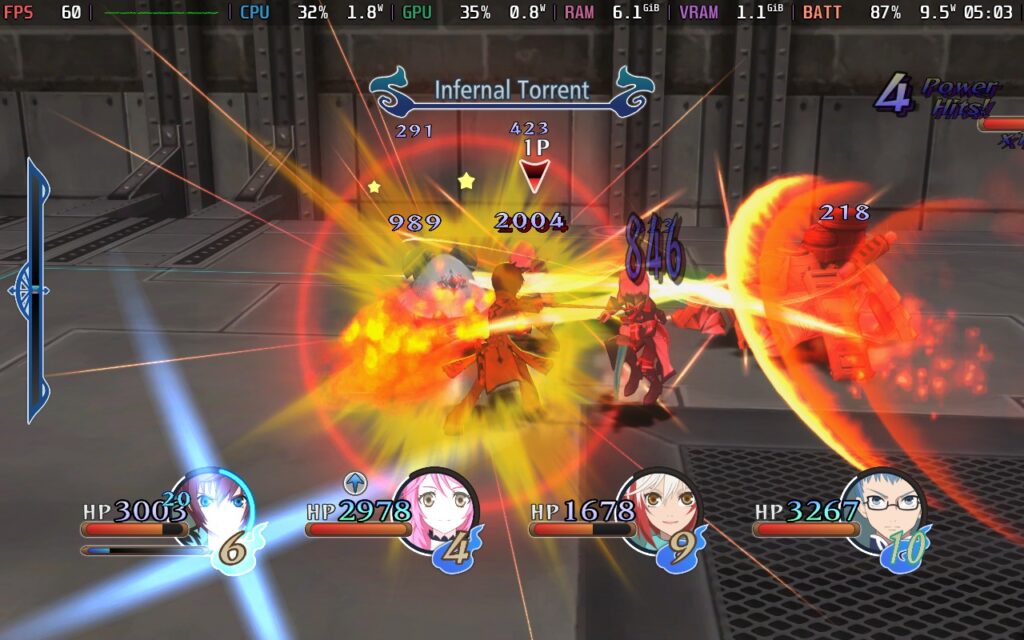
For some quick background, Tales of Graces was originally released in 2009 on the Wii, with an enhanced version that includes some extra content being released on the PS3 in 2010. The remaster is based on the enhanced PS3 version and includes almost all the DLC released for it. Outside of the graphical upgrades, which include higher resolution support and updated textures, there are also new quality-of-life features like faster dashing in the overworld, turning off enemy encounters, skippable cutscenes and skits, autosave, navigation icons so you know where to go next, a retry feature for regular battles, and more.
You can see the full list of these updates on Bandai Namco's website.
Tales of Grace f follows Asbel, the son of the lord of the town Lhant, as he travels across the world to save his friend, King Richard, and save the world. Throughout his travels, he grows his party with a cast of characters that includes childhood friends, his brother, and a girl who has lost her memory that he met seven years prior but thought she was dead. Now, the team will have to face an uphill battle as countries prepare for war, and Richard is hell-bent on making humanity extinct, threatening the well-being of every human.

I will try to keep spoilers out, but the story is solid. Even though it can be quite predictable at times, I was still engaged with the plot and its direction. I did guess some of the key plot points correctly, like the identity of the amnesiac girl Sophie, but I was a bit surprised by Richard's transformation and why he started behaving so erratically. At its core, it's a tale of friendship, emphasized by Asbel's desire to be stronger to protect everyone. It can sometimes feel a little cringey since he is a bit one-dimensional in this regard, but it still ends up being a charming and light-hearted adventure worth experiencing.
But if there's one thing the Tales series does best, it is character development. Tales of Graces f's cast is by far one of my favorites. Each character has a clearly defined personality shown as you progress through the game. Most of my favorite moments are from the game's skits, which are small side conversations that you can trigger manually. These follow your party having random conversations about what they find, what's happening around them, or certain parts of the story you are encountering, and are helped by the solid voice acting that makes what they say believable.
They can also illuminate some of the characters' quirks, like the childhood friend Cheria's fear of ghosts and love of cooking or Sophie's obliviousness to sarcasm, while starting to show more of her anxieties as the story progresses and she learns more about the world. The skits flesh out each character, showing sides we wouldn't have seen regularly or doubling down on some of their key traits. On top of skits, there are usually some comedic moments between your characters after a battle is over on the results screen, which works wonderfully with the skits to make these protagonists feel more human.
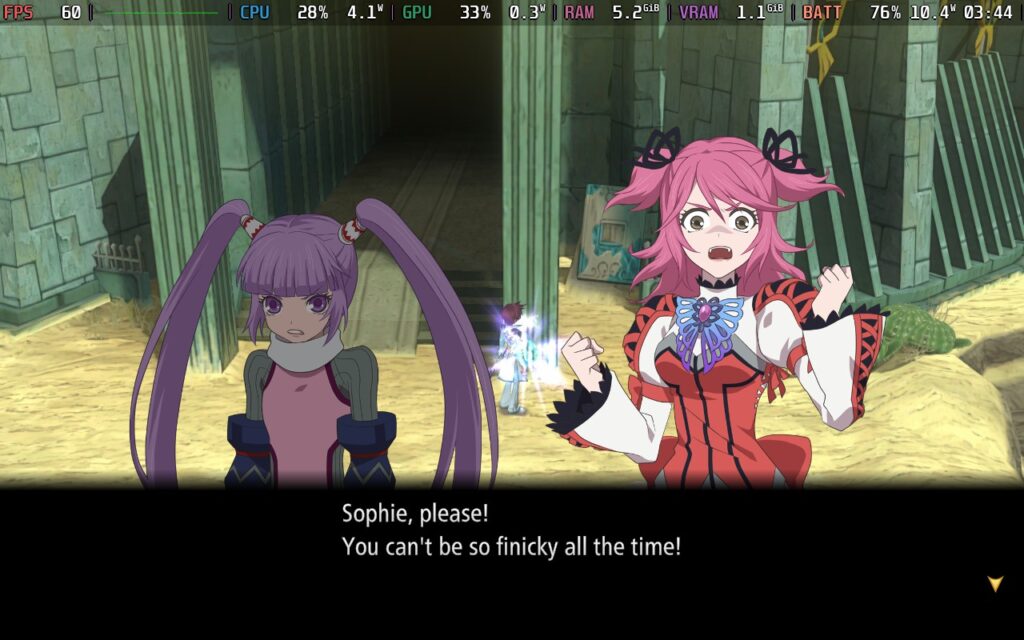
Visually, Tales of Graces f sticks to the older Tales games, using a combination of 3D cel-shaded models for general gameplay and 2D anime-esque designs for some cutscenes, skits, and UI. I have always liked this style, which I feel treads a fine line between being too cartoony and overly detailed. The cel-shading helps make the 3D aesthetic look good, even for a game that's 15 years old.
However, unlike the older Tales games, Tales of Graces f's combat feels heavily improved. Unlike traditional JRPGs, combat is real-time action instead of turn-based. You run around a contained arena generated when you run into an enemy in the overworld and fight using a combination of different attacks. You have your normal attacks, called A-Arts, and skills, called B-Arts. You can equip four B-Arts at any given time, and they can be activated based on the direction of the left joystick. Similarly, A-Arts can have different attacks and combos based on the left joystick, but they can't be customized.
Every attack will consume something called CC, which generates during combat when you are blocking or aren't attacking. You have a minimum and maximum amount of CC you can hold, and this can be increased with certain armor you equip or by completing titles (more on this in a bit). Attacking will also increase your Eleth meter, and once it's full, you can utilize ultimate attacks that can demolish your enemy's health.
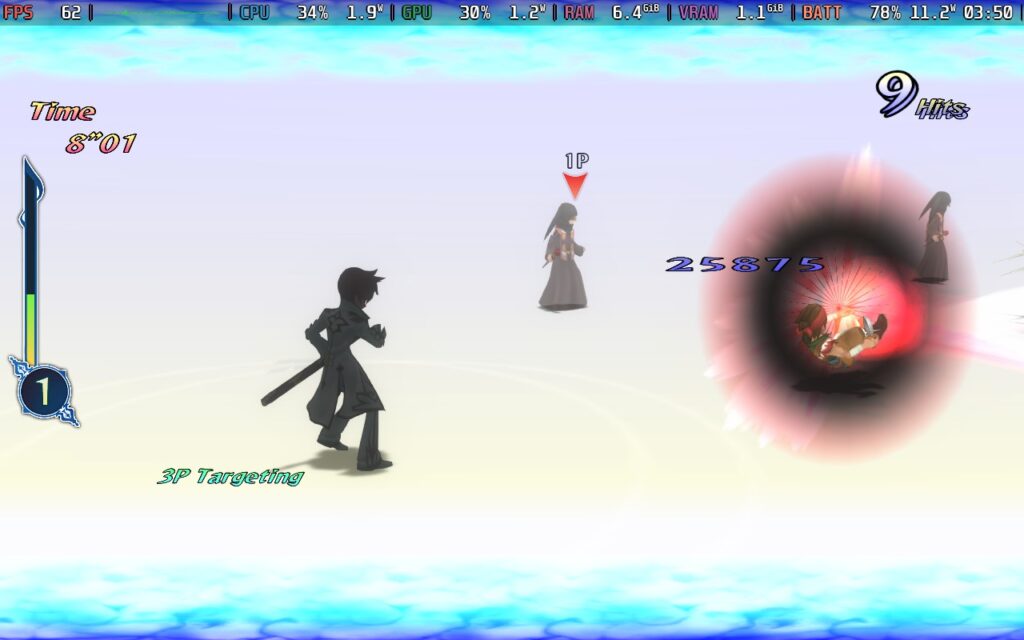
Balancing these mechanics in fast-paced battles is a blast, and I have found myself getting lost in fighting enemies to grind instead of continuing the story. The way you combine all of your arts while also balancing blocking and regaining your CC to defeat monsters feels great. There are some other mechanics, like using items and dictating which Arts the rest of your team, that I never really used unless one of my team (or myself) died, but otherwise, I never really needed those.
To get new B-Arts, you will get Titles you can equip on your fighters. These can be ranked up 5 times, and from doing this, you can learn new Arts, increase some of your stats, and get some passive abilities to increase crit rate, upgrade already learned Arts, increase your health, and more. You get more titles by getting further in the story or your actions in and out of combat. There are over 150 titles, so gathering and ranking them all up will take a while. You can also level up and get equipment to increase your stats outside of titles.
Dualizing is another big system you can use to enhance your stats. You can use Dualizing to combine two items, which you can use to enhance your armor and weapons by combining them with items you pick up from battles. This upgrades the equipment's stats, and after using them for a while, you can combine them with other Dualized weapons to create gems that you can equip for some extra stat bonuses. You can then combine those gems to upgrade their stats further, which will make you more powerful.
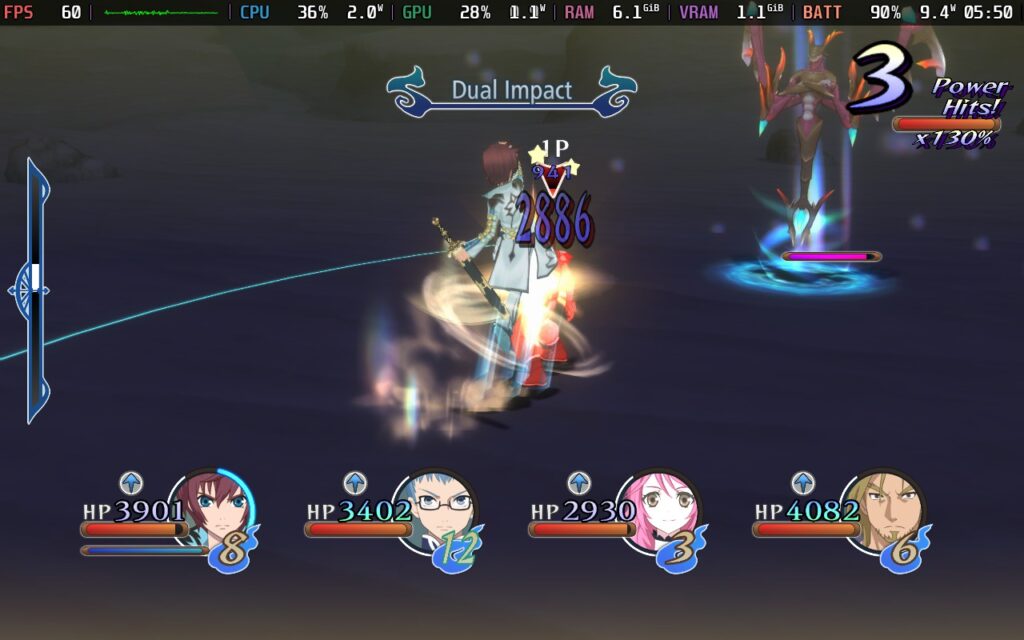
Dualizing itself is a simple but surprisingly deep mechanic. On its surface, you just combine items, but the layers keep going. Not only can you keep combining items to make the best gems possible, but there are ways to increase the rarity of the items and gems you dualize further to get even more favorable results. It was a little complicated to understand at first, but the more I used it, the more I started to understand. Having the stats or rarity be in yellow or green text if they are getting bonuses or can increase rarity also helps.
Outside of combat, you will be running around the world, going back and forth to new and old locations to complete your mission. I wish there was less running around from place to place or some way to run even faster, but it isn't horrible, thanks to the engaging combat. I also appreciate that the monsters are visible in the overworld, so there aren't any random encounters.
You can also find shops to buy new items and weapons/armor and go to Inns to find some requests/side quests to get you more gold and rank-up titles. The side quests aren't easy to figure out alone, but you can usually figure it out by listening to what they are saying or reading the request. There are also some mini-games scattered around, so there are some ways to break up the main gameplay loop.
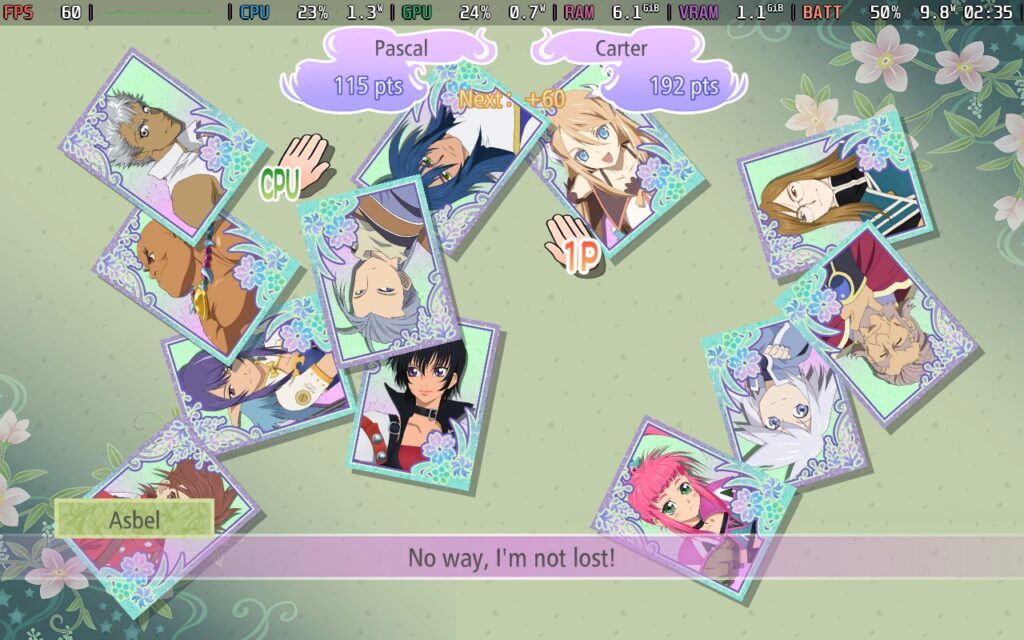
And the best way to experience all of this is definitely on the Steam Deck.
With Tales of Graces f, I did not doubt this would be a blast to play on the Steam Deck. The original was released in 2009 for the Wii and in 2010 on the PS3. It's a much older game, so it shouldn't have any issues running on the Deck, and it doesn't. The game hits 60 FPS wonderfully, and playing in the palm of my hand feels fantastic. I did try to play at 90 FPS, but it hard-capped me at 67 FPS in some areas. However, one small issue plagues this release: Battery Drain.
The game doesn't drain much battery, but it did drain more than I expected for a game like this at times. I saw upwards of 15W drain in some areas, and while it did go back down to the 11W average, I found it weird. Without changing settings, I set a TDP limit of 7, keeping the battery drain down to a 9.5W average. There is some very slight instability here and there, but it's nothing noticeable unless you watch the frame graph.
I also found some minor areas that seem to impact performance. When I went into areas, I sometimes dropped the frame rate to around 45 FPS for a couple of seconds before going back up, and I found one spot that spiked the battery drain and hurt performance more. This only happened once, and afterward, I returned to the same area, and it didn't happen again. While this happened, I did try to turn the TDP limit off, but the issues were still present.
Because there was no change when the limit was off, I believe having the TDP limit on won't affect these problems much. Outside of those performance drops, which happened regardless of the limit, I was playing at a solid 60 FPS with low battery drain, and it felt great:
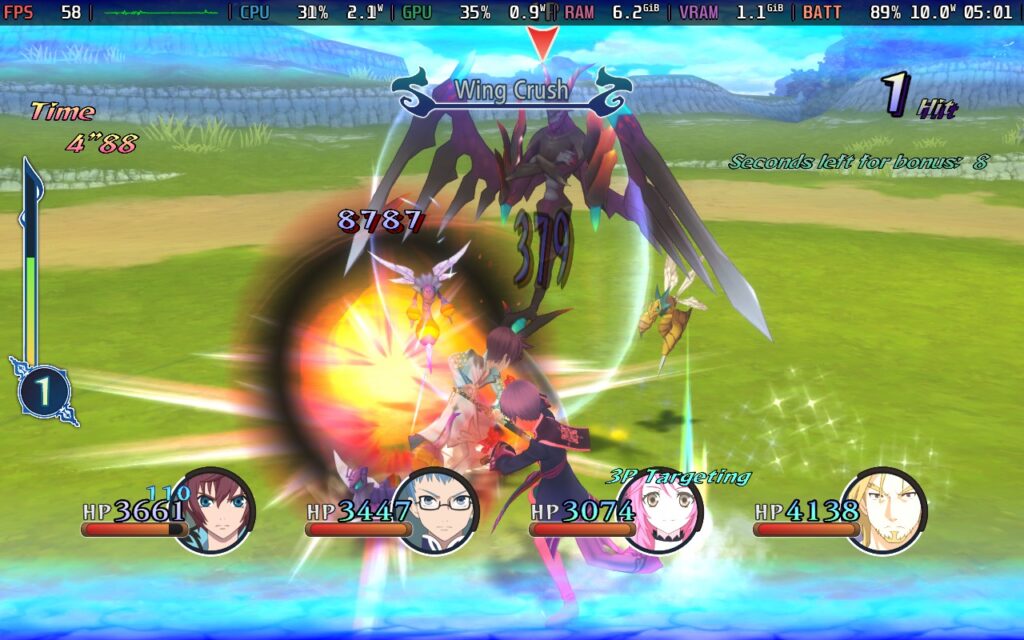
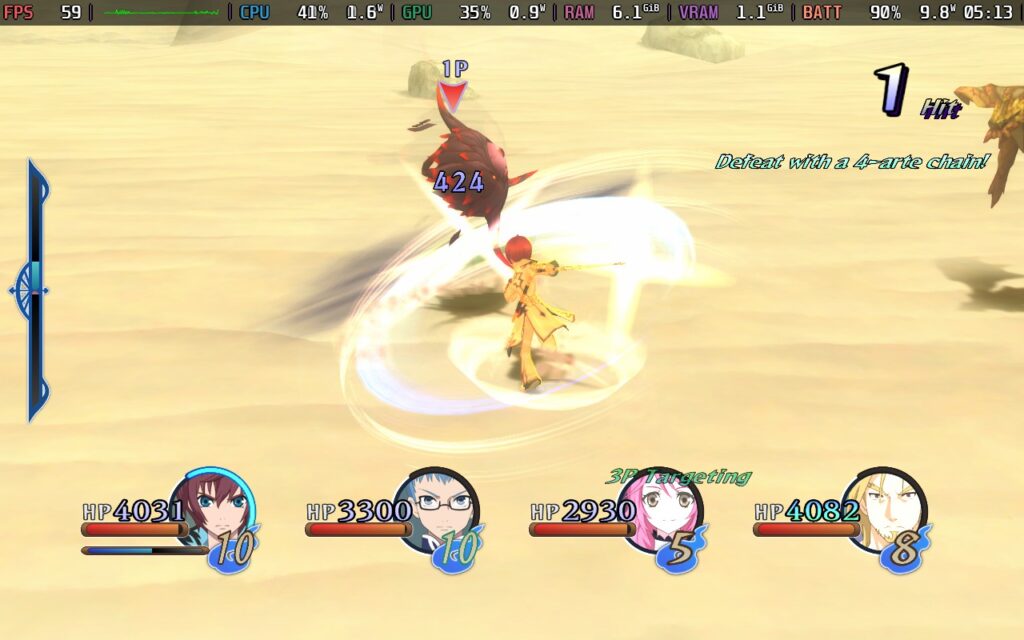
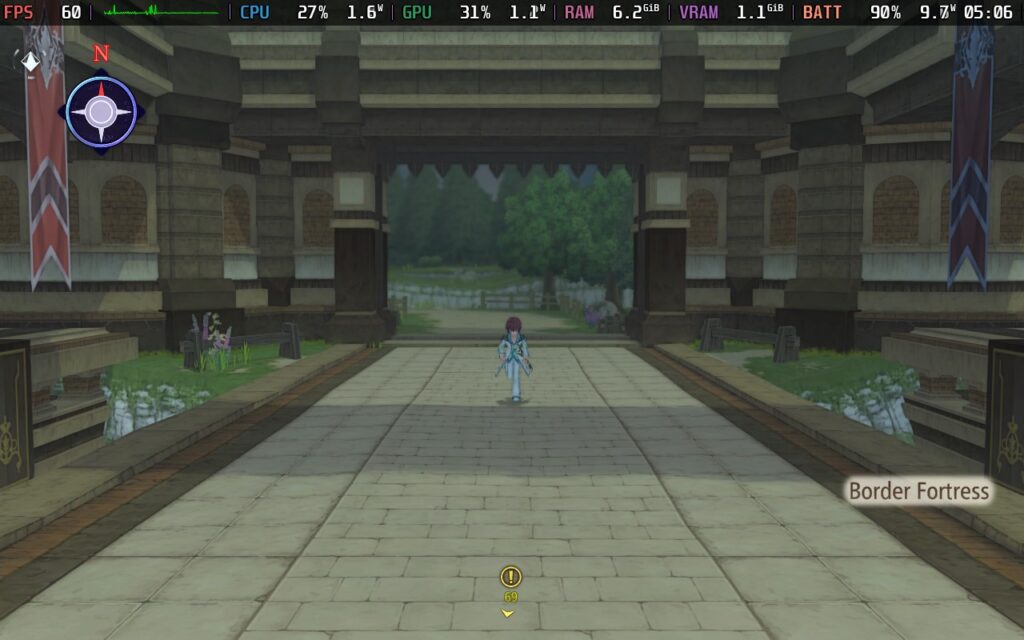
In the settings, you can change the difficulty, the battle camera, change message speed, and toggle encounters, vibration, auto-advancing text, subtitles, voice-over language, and sound bars. You can also configure the battle music playlist, which includes music from other Tales games, customize keybindings, and access the Grade Shop.
The game does support 16:10 resolutions, as well as cloud saves and controller support. There are no HDR settings.
Tales of Graces f has become one of my favorite games in the series. The combat feels amazing and addicting thanks to the fast-paced action and great progression depth with the Titles and Dualize system. The story isn't the most surprising, but the cast of characters is fantastic and carries the plot as it continues. The visuals hold up nicely, too, thanks to the cel-shaded aesthetic. It can be a little obnoxious to run from place to place, and the story is predictable at times, but it's still an incredible way to experience one of the best Tales games in existence.
It also runs wonderfully on the Steam Deck, with only some minor issues here and there that are inconsistent. Since the issues don't always pop up, I would say this is a safe bet to play on your Deck without problems, and I recommend setting the TDP limit a little lower to save on battery without compromises.
Our review is based on the PC version of this game.
If you enjoyed this review, be sure to check out the rest of the content on SteamDeckHQ! We have a wide variety of game reviews and news that are sure to help your gaming experience. Whether you're looking for news, tips and tutorials, game settings and reviews, or just want to stay up-to-date on the latest trends, we've got your back.
Tales of Graces f Remastered is a fantastic version of the 2009 original that still holds up today, and is wonderful on the Steam Deck.
